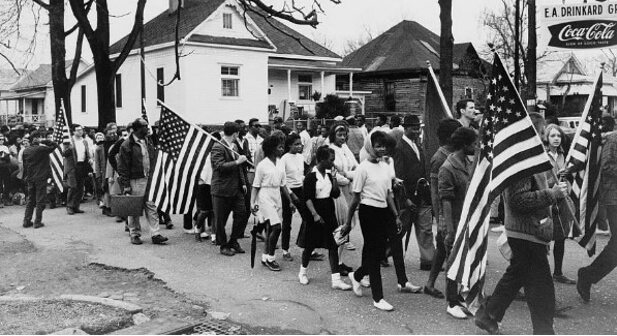4. The story displays the power of non-violent resistance to injustice.
Three days after the world-attention-grabbing march from Selma to Montgomery, Martin Luther King Jr. was on NBC’s Meet the Press. This 30-minute interview, preserved on YouTube, is a stunning follow-up to the movie. In it the real, historical King gives reasoned responses to fairly hostile questioning. In the process he articulates the philosophy of non-violent resistance:
There are two types of laws. One is a just law. One is an unjust law. I think we all have moral obligation to obey just laws. On the other hand, I think we have a moral obligation to disobey unjust laws, because non-cooperation with evil is as much a moral obligation as is cooperation with good. I think the distinction here is that when one breaks a law that his conscience tells him is unjust, he must do it openly, he must do it cheerfully, he must do it lovingly, he must do it civilly, not uncivilly, and he must do it with a willingness to accept the penalty. And any man that breaks a law that his conscience tells him is unjust and willingly accepts the penalty, by staying in jail in order to arouse the conscience of the community on the injustice of the law, is at that moment expressing the highest respect for law.
That is the deeper and larger drama that the movie displays.
The irony is that non-violent resistance elicits violent reactions. Three demonstrators were killed. Jimmy Lee Jackson was shot by State Trooper, James Fowler, on Feb. 18, after being tracked down into Mack’s Café after a peaceful demonstration. On March 9 James Reeb, a Unitarian minister from Boston, and two other clergymen were beaten by white men armed with clubs. Reeb died two days later. Five hours after King’s hope-filled speech in Montgomery, Viola Liuzzo, a white demonstrator from Detroit, was shot and killed by whites. The first two of these were depicted graphically in the movie.
Though King will trace the influence on his non-violent approach back through Gandhi to Socrates, there is no doubt that Jesus was the key influence.
“You have heard that it was said, ‘An eye for an eye, and a tooth for a tooth.’ But I say to you, do not resist an evil person. But whoever strikes you on your right cheek, turn to him the other as well. And if anyone sues you in a court of law and takes away your tunic, let him have your cloak also. And whoever compels you to go a mile, go with him two” (Matt. 5:38-41).
And the apostle Paul gave the deeper rationale for such behavior:
“Beloved, do not avenge yourselves, but rather give place to God’s wrath, for it is written: ‘Vengeance is Mine. I will repay,’ says the Lord. Therefore ‘If your enemy is hungry, feed him; if he is thirsty, give him a drink; for in doing so you will heap coals of fire on his head'” (Rom. 12:19-20).












